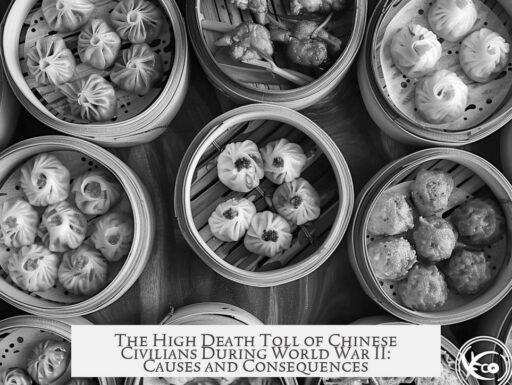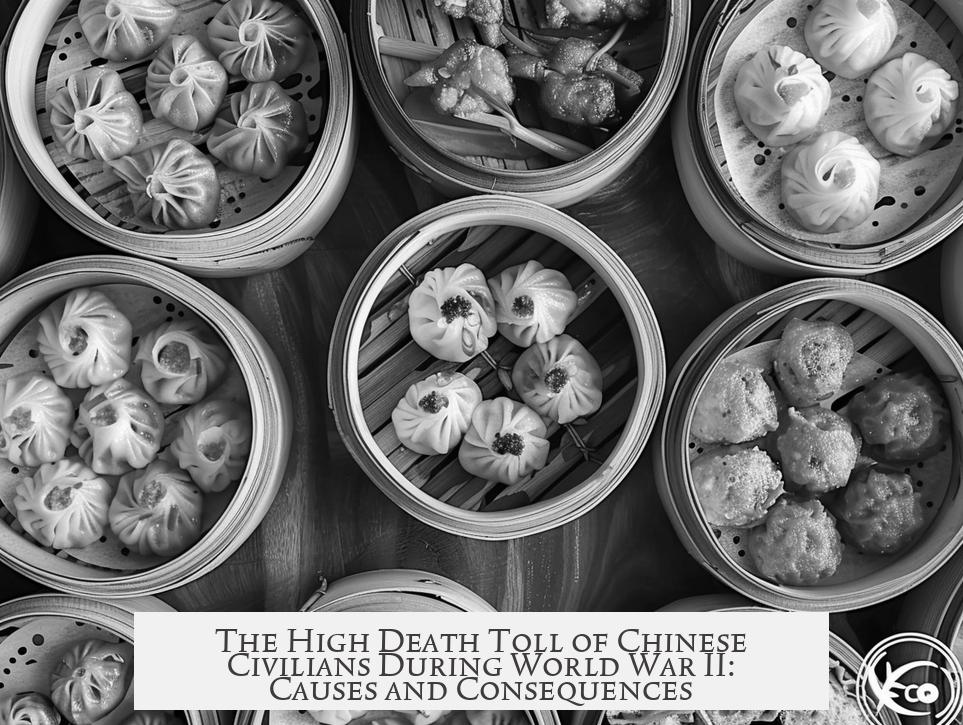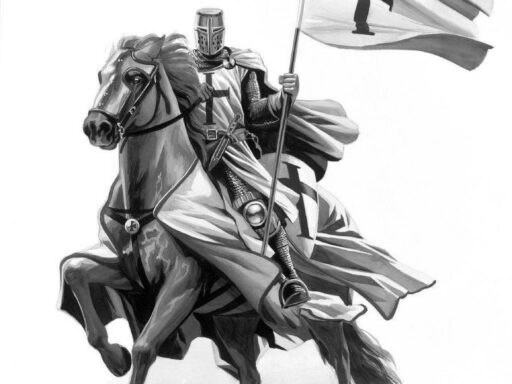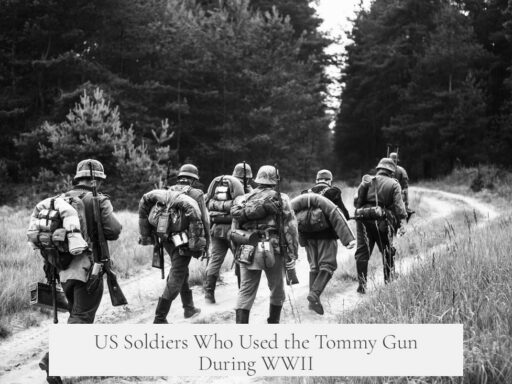The high death toll of Chinese people during World War II results from a combination of brutal military conflict, widespread famine, flooding, displacement, and disease. The number of Chinese casualties is estimated to be between 8 and 20 million, reflecting both direct violence and indirect causes such as starvation and natural disasters exacerbated by the war.

Estimating the exact number of deaths in China during World War II poses challenges. Unlike Western countries, China lacked precise casualty records. Estimates vary widely, with some scholars placing the total deaths at around 14 to 20 million, while others suggest numbers as low as 8 million. These differences are partly due to inconsistent population data and the vast scale of civilian suffering.
- Rana Mitter estimates 14 to 20 million, preferring the lower half of this range but acknowledging uncertainty.
- Rudolph J. Rummel and Guo Rugui estimate 14 million deaths, including 2 million military and 12 million civilian.
- Diana Lary’s estimate reaches 18 million, though it relies on flawed population figures.
- Meng Guoxiang provides the lowest estimate at 8 to 10 million.
- John Ellis calculates approximately 9.4 million total deaths, with 3.2 million military and 8 million civilian casualties.
The extreme brutality of the Sino-Japanese conflict is a key factor. The occupation and battles included notorious episodes, such as the Rape of Nanking, which caused tens or hundreds of thousands of civilian deaths. Such atrocities contributed heavily to the high civilian toll.

Another crucial cause of Chinese deaths was famine. The 1942 Henan famine alone caused between 1 and 5 million deaths. This famine resulted from a combination of drought, locust infestations, harsh Japanese occupation policies, and deliberate flooding ordered by the Chinese Nationalist government. The Nationalists aimed to slow Japanese advances by destroying the Yellow River dams, which flooded 70,000 square kilometers and drowned roughly 800,000 people.
From Anthony Garnaut’s study, the Henan famine was a “perfect storm” of natural and wartime factors causing immense loss of life.

Flooding was widespread in China during the war. Aside from Henan, Yellow River tributaries experienced frequent, sudden floods. Survey data show millions of disaster victims and people needing relief outside battle zones, far exceeding those in frontline areas. For example, in Henan flooded regions, nearly 2 million were disaster victims, and over 1.2 million required relief. Other flooded areas had over 4 million victims and nearly 3 million needing assistance.
The war induced massive displacement. Millions fled their homes, facing food shortages and poor living conditions—ideal for disease outbreaks. Medical infrastructure was minimal; for instance, Henan had only two hospitals with about 150 beds to serve its 30 million residents. Medical care was rudimentary, worsening civilian survival chances.

Deaths often resulted from indirect causes. Many Chinese civilians died not directly from fighting but from starvation and flooding. Henan exemplifies these overlapping tragedies but reflects broader national suffering. Across China, famine, flooding, displacement, and disease combined to claim millions of lives.
| Cause | Impact on Deaths |
|---|---|
| Military Conflict & Atrocities | Millions of civilian and military deaths, including mass killings like Nanking massacre |
| Famine | 1 to 5 million deaths in Henan alone; starvation widespread during wartime disruptions |
| Flooding | ~800,000 drowned due to deliberate dam destruction and natural floods; several million displaced |
| Displacement & Disease | Overcrowding, lack of food, and limited healthcare caused disease outbreaks and increased mortality |
These causes intertwined, each worsening the impact of the others. The Chinese population suffered severe hardship as the war disrupted food production, infrastructure, and governance. The battle zones were sometimes less deadly in terms of direct casualties than the environmental and social devastation uncontrolled by the conflict.

Key reasons for the high Chinese death toll in World War II include:
- Exceptional violence and war crimes by invading Japanese forces.
- Massive famine triggered by drought, plagues, and wartime occupation.
- Deliberate flooding by Chinese forces to impede enemy progress.
- Displacement of millions, leading to widespread disease and starvation.
- Weak healthcare infrastructure unable to cope with combined stresses.
Estimates vary, but the scale of the tragedy remains undisputed. China lost more people than most other countries in World War II. These losses reflect the complex interaction of military, environmental, and social factors during one of the most brutal theatres of the war.

Why Were So Many Chinese Killed in World War II?
The staggering loss of life among the Chinese during World War II results from a combination of brutal warfare, widespread famine, deliberate flooding, and poor infrastructure—leading to millions of deaths both directly and indirectly. While it’s tempting to look for a neat number, the reality is far more complex, with estimates varying wildly. So let’s dive into this heavy topic and unravel why China suffered so profoundly during those years.
To start, the death toll is a moving target. Historians and scholars argue numbers that shift by millions, reflecting the chaos and data limitations of that era. Unlike the UK or the US, where casualty records were precise, China’s tallies hover in the realm of “*give or take a million*.” That’s a gigantic margin for error, which says a lot about the scale and confusion surrounding these tragic events.
Varied Estimates from Experts
Different scholars disagree quite a bit. Rana Mitter argues somewhere between 14 and 20 million Chinese died—leaning toward 14 million but admitting it could be more. Rudolph J. Rummel and Guo Rugui break it down with 2 million combat deaths plus 12 million civilian casualties totaling 14 million.
Diana Lary suggests the number could be as high as 18 million, based on population changes—though that data is a bit shaky. On the other hand, Meng Guoxiang offers a lower estimate of 8 to 10 million.
Military casualty specialist John Ellis counts roughly 3.2 million total military casualties. He adds about 8 million civilian deaths, making a combined total of just over 9 million. Numbers fluctuate because of different data sources and definitions of casualties—wounded, missing, civilian, or military—but the main point remains: it’s in the many millions.
What Made This War So Deadly?
The conflict between China and Japan ranks among the most horrifically brutal in WWII. It wasn’t just about bullets and bombs. Take the infamous Rape of Nanking—where Japanese forces slaughtered tens of thousands, possibly hundreds of thousands of civilians. This atrocity highlights the savage nature of fighting in the Chinese theater.
But brutal violence is only one part of the story.
Famine: The Silent Killer
Many deaths resulted from famine and flooding. The 1942 Henan famine alone caused between 1 to 5 million deaths in a province with about 34 million people. Causes combined natural and human-made disasters: drought, locust swarms, Japanese occupation, and intentional flooding by Chinese Nationalists.
The Nationalists reported nearly 1.5 million deaths but probably underplayed those figures for political reasons. International aid trickled in but was too limited to prevent mass starvation.
Anthony Garnaut’s research paints a stark picture of how famine devastated Henan’s population. It serves as a harsh reminder that food shortages in a war zone can be as lethal as any weapon.
Flooding: A Deliberate Military Strategy with Tragic Civilian Costs
Chiang Kai-Shek made a devastating decision during the war. He ordered the destruction of dams on the Yellow River to slow the Japanese advance. The flooding affected 70,000 square kilometers, drowning around 800,000 civilians, displacing millions, and worsening famine conditions.
This wasn’t an isolated incident. Throughout the war, the Yellow River and its tributaries frequently flooded, pushing refugee numbers even higher. Micah S. Muscolino’s surveys show that flood victims far outnumbered those in frontline combat zones.
- Henan flooded regions: nearly 2 million disaster victims, over 1.2 million needing relief.
- Other flood areas: more than 4 million disaster victims, with 2.7 million requiring help.
- Battle zones: roughly 675,000 victims and 520,000 in need of aid.
This data highlights the massive humanitarian crisis triggered by these floods.
Displacement, Disease, and Crumbling Medical Care
War breeds chaos. Millions of civilians were displaced and stranded in harsh conditions. Food scarcity worsened every day, creating fertile ground for disease outbreaks. Medical infrastructure was nearly nonexistent—Henan Province, for example, had only two hospitals and about 150 beds for over 30 million people.
Doctors and nurses operated in extremely challenging conditions, trying to contain epidemics without enough supplies or personnel. This likely increased civilian mortality significantly.
Putting It All Together
The high civilian death toll wasn’t just from bullets or bombs. Most Chinese deaths happened because of the brutal environment citizens were forced into—famine, flooding, displacement, and illness all took a terrible toll.
Henan Province exemplifies the tragedy. Though one of the hardest-hit regions, the tragedies there reflect the war’s broader impact across China. The sheer scale of the suffering remains difficult to grasp but essential to remember.
Why Should We Care?
Understanding why so many Chinese died is more than a historical exercise. It reminds us how war affects civilians in ways beyond combat. Sometimes, military strategy or environmental disaster can be far deadlier than any bullet.
As we reflect, consider: how can we better protect civilians today when conflicts erupt? And how could better international aid have changed the course of suffering in 1940s China? These questions matter as much now as then.
So next time you think of WWII, spare a thought for the millions of Chinese lives caught between armies, famine, and floods. Their story is a vital part of the larger history we must never forget.




